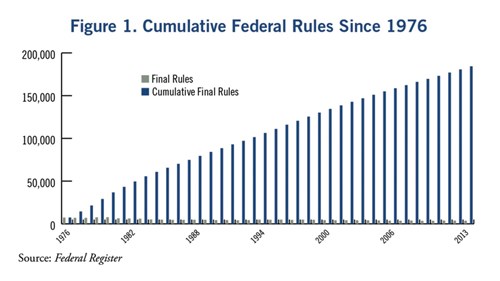Regulatory Burden: Real Numbers, Real Problem
The cost burden of federal regulations on small businesses works out to almost $5.29 per employee hour worked.
The Small Business Administration Office of Advocacy estimates the cost to comply with federal regulations amounts to $7,775 per employee for large companies, and $10,585 per employee for small businesses. That $10,585 works out to a rate of about $5.29 per small business employee hour worked, just to cover the cost of compliance with federal regulations.
Why the focus on small business? Because our industry is one of small businesses. In fact, 89 percent of U.S. businesses are considered small businesses. For manufacturing, the SBA defines a “Small Business” as 500 employees. The SBA report indicates the costs per employee for small businesses are 36 percent greater than for large businesses.
Annually, it costs about $2,830 more for small firms to comply than their larger counterparts, on a per-employee basis, according to the SBA.
Put another way, that $2,830 cost disadvantage for small firms, compared with large firms, amounts to a higher cost for small businesses of about $1.42 per hour worked per employee. This cost reflects smaller firms’ higher costs to comply with federal regulations. “The compliance cost for small manufacturers is more than double the compliance cost for medium to large firms, 100 and 125 percent respectively,” according to the SBA Small Business Research Summary Highlights.
Compliance costs are higher for manufacturing. According to the SBA, “Compliance costs per manufacturing worker are nearly double the amount per service worker, and represent almost 29 percent of manufacturing firms’ payrolls.”
That’s a burden. No wonder there was a push to manufacture goods overseas.
These costs may not seem significant when looked at on a per-hour or per-employee basis. And who really wants to do the math with almost 160 million employees? So let’s take a look at this from a household basis. We are, after all, a nation of households. What do these regulations cost on a per household basis to our citizens?
“Had every U.S. household paid an equal share of the federal regulatory burden, each would have owed $15,586 in 2008.”
The cost of federal regulations, when examined in terms of the number of households, is more than $15,586 annually. This is more than double the federal taxes paid by the middle quintile (average) of taxpayers from 2007-2009, which were $7,200 according to Table 3 of “The Distribution of Household Income and Federal Taxes, 2008 and 2009.”
(Link: short.productionmachining.com/household)
What exactly are we getting for our $15,586?
Looked at from the perspective of a household, that (average tax-paying segment or middle quintile grouping) had before-tax income of $64,300, the average federal tax liability of $7,200 works out to just over 11 percent of income. The cost of federal regulations, on a per-household basis, amounts to approximately 24 percent of household income, more than double their actual tax liability.
Are we getting value for our almost one quarter of income being used to regulate businesses on our behalf?
When we look at the cost of federal regulations in terms of the U.S. national income, it becomes even clearer: 14 percent of U.S. national income is consumed by regulatory compliance expense, according to the U.S. SBA. About 21 percent of U.S. national income is consumed by U.S. tax receipts. That means that more than 35 percent of our national income is consumed by the federal government, and 40 percent of that is a hidden, unseen burden on us all. The higher costs of products and doing business because of regulations forces prices higher and lowers the demand for workers. The U.S. is currently sacrificing more than one third of our income to support the federal government and its regulatory bureaucracies. We think this is excessive, and yet, in fact, it is dramatically understated.
Understated, because these are 2008 data reported by SBA. These data do not reflect any of the new rules and regulations and enforcement initiatives enacted since 2008 by the current administration. And we all know that the number of regulations have continued to grow since 2008.
Regulatory burden is a hidden loss of U.S. national income by means of cost to comply with rules and regulations enforced on businesses, including small businesses like yours, by the federal government. More than $5.29 per employee hour worked is the cost of these regulations on small businesses.
Regulatory burden is a real cost, not just to our companies, but to our society. Monies dictated to be spent on “regulatory mandates” by the federal government are monies that will not be spent to help our shops to become more productive. Monies that will not be used to increase capacity and hire new employees in our shops. The federal government is consuming more than a third of our national income. And about 40 percent of that is consumed by regulation required spending on compliance costs of federal regulations.
Sources:
SBA Office of Advocacy: The Impact of Regulatory Costs on Small Firms
short.productionmachining.com/RegCosts
short.productionmachining.com/RegCosts2
SBA Size Standards Table
short.productionmachining.com/standards
Congressional Budget Office
short.productionmachining.com/household
— Precision Machined Products Association
Read Next
A Tooling Workshop Worth a Visit
Marubeni Citizen-Cincom’s tooling and accessory workshop offers a chance to learn more about ancillary devices that can boost machining efficiency and capability.
Read More5 Aspects of PMTS I Appreciate
The three-day edition of the 2025 Precision Machining Technology Show kicks off at the start of April. I’ll be there, and here are some reasons why.
Read MoreDo You Have Single Points of Failure?
Plans need to be in place before a catastrophic event occurs.
Read More










.jpg;maxWidth=300;quality=90)








